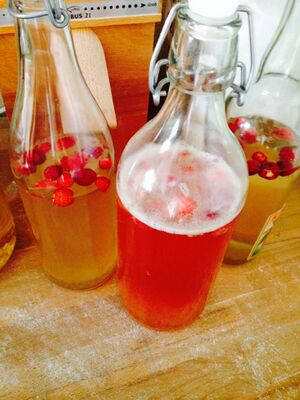Granos tibicos growing media: Difference between revisions
Samthetechie (talk | contribs) (added some structure and fixed ze good english :)) |
Samthetechie (talk | contribs) |
||
| Line 5: | Line 5: | ||
* Daniel's experiments | * Daniel's experiments | ||
= | =Experimental Summaries= | ||
==Algoldor's experiments== | ==Algoldor's experiments== | ||
For over four months I've been culturing water kefir and ginger beer plant cultures with variety of media achieving well fermented beverages of tasty flavour however failing in increasing or even keeping the amount/weight of the grains. I've used generally light brown or dark brown sugar of concentration of around 7% (w/v) so 700 g per 10 l batch, black tea was used for some time (around 0.5% (w/v)), 0.02% (w/v; 2 g) of DAP (diammonium hydrogen phosphate (NH4)2HPO4, fresh fruits etc. I've also switched from anaerobic to aerobic fermentation. It seems to me, that the ''Lactobacillus brevis,'' microbe responsible for the growth of the dextran based biofilm from which the grain is composed is missing or the conditions are not favourable for it to produce the matrix, however the later should be not the case because conditions above are in agreement with literature and experiments which have shown to provide grain growth. | For over four months I've been culturing water kefir and ginger beer plant cultures with variety of media achieving well fermented beverages of tasty flavour however failing in increasing or even keeping the amount/weight of the grains. I've used generally light brown or dark brown sugar of concentration of around 7% (w/v) so 700 g per 10 l batch, black tea was used for some time (around 0.5% (w/v)), 0.02% (w/v; 2 g) of DAP (diammonium hydrogen phosphate (NH4)2HPO4, fresh fruits etc. I've also switched from anaerobic to aerobic fermentation. It seems to me, that the ''Lactobacillus brevis,'' microbe responsible for the growth of the dextran based biofilm from which the grain is composed is missing or the conditions are not favourable for it to produce the matrix, however the later should be not the case because conditions above are in agreement with literature and experiments which have shown to provide grain growth. | ||
Revision as of 05:28, 20 November 2014
This page is dedicated to the search for the optimal growing media for granos tibicos alias water kefir which will result both in growth of the culture in amount and also in a tasty beverage. So far it is suggested to create subpages for individual projects/data of people who are experimenting with this culture. On this page we would than share brief summaries of the results of our work, literature, future aims etc.
Various experiments
- Algoldor's experiments
- Daniel's experiments
Experimental Summaries
Algoldor's experiments
For over four months I've been culturing water kefir and ginger beer plant cultures with variety of media achieving well fermented beverages of tasty flavour however failing in increasing or even keeping the amount/weight of the grains. I've used generally light brown or dark brown sugar of concentration of around 7% (w/v) so 700 g per 10 l batch, black tea was used for some time (around 0.5% (w/v)), 0.02% (w/v; 2 g) of DAP (diammonium hydrogen phosphate (NH4)2HPO4, fresh fruits etc. I've also switched from anaerobic to aerobic fermentation. It seems to me, that the Lactobacillus brevis, microbe responsible for the growth of the dextran based biofilm from which the grain is composed is missing or the conditions are not favourable for it to produce the matrix, however the later should be not the case because conditions above are in agreement with literature and experiments which have shown to provide grain growth.
Daniel's experiments
I usually prepare my water kefir mixture in two steps, the first step with grains in an aerobic environment and the second step in a closed flask with the grains removed. At the moment I add ca 40 g (5% (w/v) of grains to 24-28g (+-3% (w/v)) brown sugar diluted in 750-800g room temp water (I'm not that precise). Let it stand for 2-3 days with piece of dried fruit and transfer liquid without grains to a flask. In the second step I add ca 50-100 g (6-13% (w/v)) fruit juice or lemonade and berries and/or dried fruit at wish. Let stand with closed lid for 2-3 days. Drink. If not enough fizz, let stand longer. I usually leave some 3 cm space in the top and my feeling is that the pressure and fizz is larger if I reseal the flask after having drunken half of it -probably due to more available oxygen in the flask.
